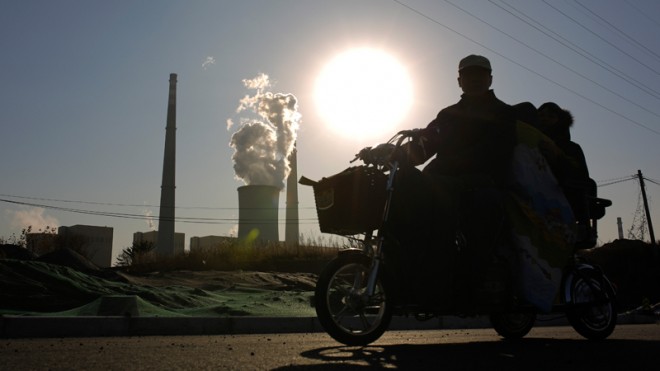China must change economy to meet climate targets

A family riding an electric tricycle bike is silhouetted against the sun setting on a coal-fired power plant in Beijing, China Thursday, Nov. 13, 2014. Chinese leaders pledged for the first time to cap the country’s decades-long growth of greenhouse gas emissions. Since China emits more carbon and other heat-trapping gases than any other country, the pledge boosted global efforts to prevent catastrophic climate change. Fulfilling its pledge, however, will require China to transform a booming economy that still largely depends on polluting industries such as steel production and manufacturing. (AP Photo/Andy Wong)
BEIJING — Chinese leaders pledged for the first time to cap the country’s decades-long growth of greenhouse gas emissions. Since China emits more carbon and other heat-trapping gases than any other country, the pledge boosted global efforts to prevent catastrophic climate change. Fulfilling its pledge, however, will require China to transform a booming economy that still largely depends on polluting industries such as steel production and manufacturing. Yet the country has important advantages, having already developed enormous capacities for solar, wind and other renewable energy sources.
WHAT CHINA HAS PLEDGED:
China pledged to halt the growth in its greenhouse gas emissions around 2030 or earlier if possible. It didn’t, however, specify a peak emissions level. It said it would produce a fifth of its total energy from non-fossil fuel sources, including nuclear energy, by 2030. That would double the current share of non-fossil fuels in the country’s energy mix.
China accounts for about 30 percent of global emissions and releases double the amount of greenhouse gases than the United States, the world’s second-biggest emitter. U.S. government estimates show China doubling its emissions by 2040 without major changes.
WHAT IT’S ALREADY DONE:
Article continues after this advertisementChina produces more solar panels and wind turbines than any other country and has built dozens of dams inside and outside the country to produce hydropower.
Article continues after this advertisementAccording to a National Energy Administration plan, China will boost hydropower to 290 gigawatts next year, marking 6 percent annual growth since 2010. Wind power will hit 100 gigawatts, marking 26 percent annual growth, and solar power will reach 21 gigawatts at 90 percent annual growth.
Many cities such as the capital, Beijing, are plagued by extreme air pollution and have started phasing out coal burning. The central government is now considering a nationwide cap on coal use. This year, coal consumption dropped in China by 1 to 2 percentage points.
THE CHALLENGES CHINA FACES:
The world’s most populous country has built its powerhouse economy over three decades in large part through dirty industries such as steel production that depend heavily on coal power and release millions of tons of heat-trapping carbon into the atmosphere every year. Chinese leaders have set targets of about 7 percent economic growth a year, and officials are evaluated based on hitting those economic targets, not environmental ones. On top of that, hundreds of millions of Chinese are buying cars, appliances and other goods, which only add to energy demand.
Coal generates about 80 percent of the country’s electricity, so cutting carbon emissions will require overhauling China’s energy mix. At the very least, the country needs to hit coal reduction targets at least five years before 2030 to meet the goals announced this week, said Alvin Lin, China climate and energy policy director with the U.S.-based NaturalResources Defense Council.
The country also must implement and enforce tougher energy efficiency standards. The price for energy as well as water for many Chinese is subsidized, which discourages consumers from conserving.
THE POSSIBLE SOLUTIONS:
China needs to expand and accelerate what it’s started. That means overhauling energy infrastructure to use more renewable sources and creating incentives for consumers, especially commercial and industrial users, to switch to renewables and to conserve energy.
The country’s banks and governments could help by making more financing available for energy users to install solar panels, said Rosie Pidcock, a Beijing-based business development manager with the U.S. company Urban Green Energy. The U.S. government, for example, provides a generous tax break to people who install solar panels and other renewable energy equipment.
“If the government could step in to do more guarantees to help rooftop solar reach that point where it’s recognized, that would help because the economics are certainly there but financing is lagging behind in enabling those installations to scale up more quickly,” Pidcock said.
China also needs to build more energy-efficient power plants and buildings, as well as better quality wind turbines and other clean energy infrastructure, said Gianluca Ghiara, a Beijing-based renewable energy consultant. So far, Chinese-made wind turbines still lag behind most European-produced turbines in product life, he said.
“China so far is focused on building huge plants, enormous plants,” Ghiara said. “China should start to think that it’s not a matter of building plants. It’s a matter of the efficiency of plants, the performance of plants.”
And according to the official Xinhua News Agency, China and the U.S. will work together to build a major carbon storage project in China that would pump carbon underground and prevent it from reaching the planet’s atmosphere. The world’s first large-scale power plant to store carbon produced from burning coal just opened last month in Canada.